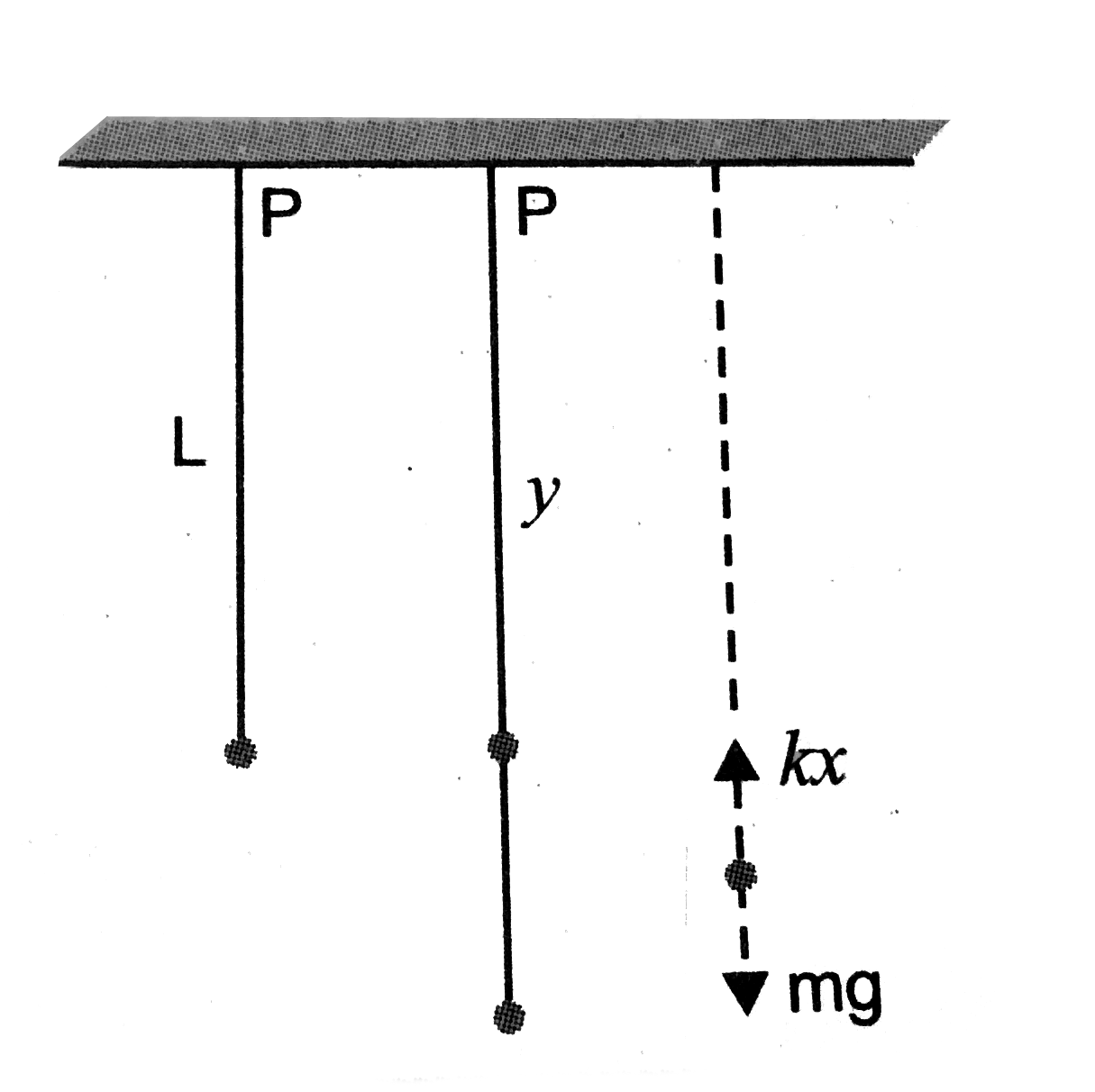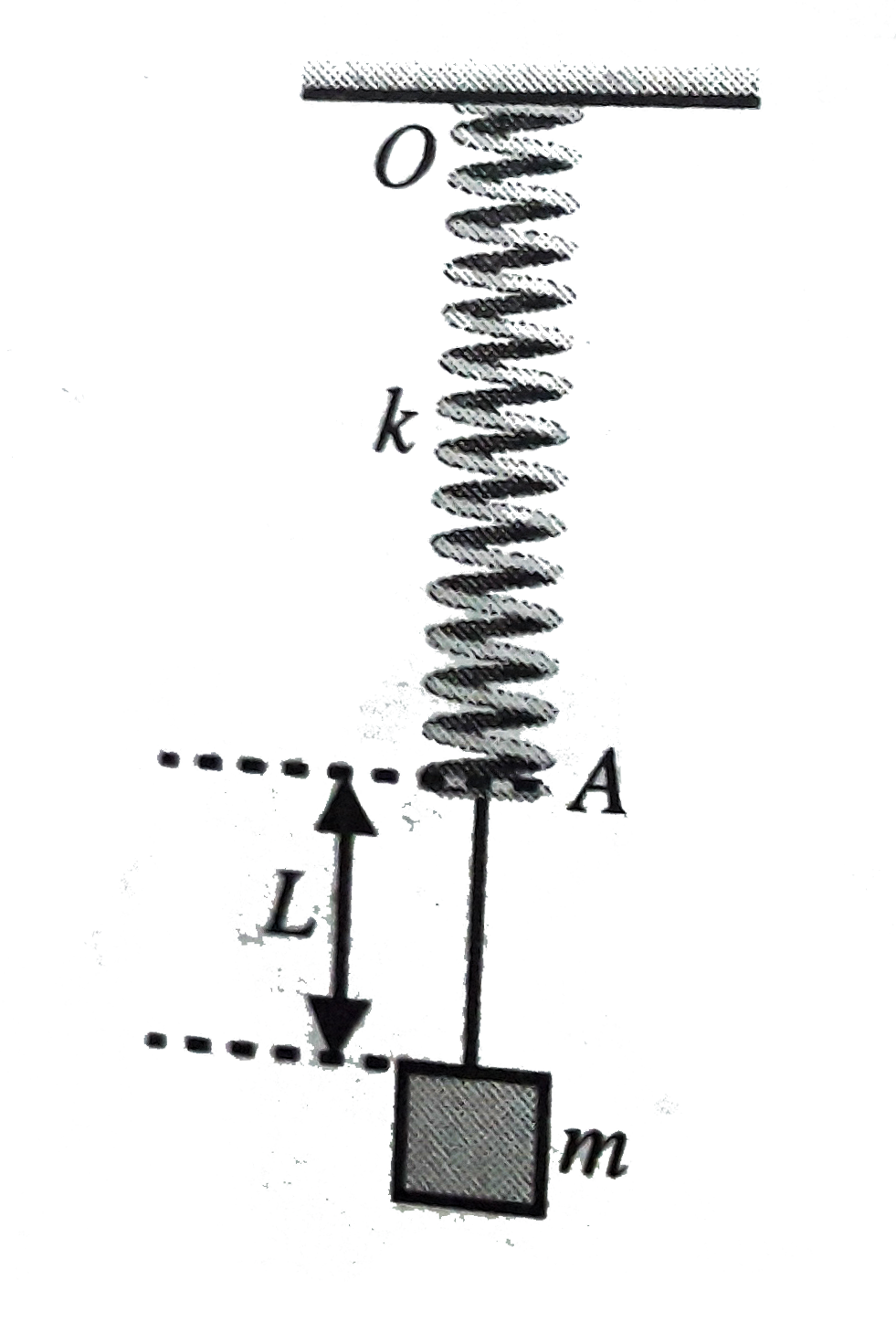A stone of mass m is tied to an elastic string of negligble mass and spring constant k. The unstretched length of the string is L and has negligible mass. The other end of the string is fixed to a nail at a point p. Initially the stone is at the same level as the point P. The stone is dropped vertically from point P.
(a) Find the distance y from the top when the mass comes to rest for an instant, for the first time.
(b) What is the maximum velocity attained by the stone in this drop?
(c) What shall be the nature of the motion after the stone has reached its lowest point?
(a) As the stone falls vertically through length L, it is in free fall. After that the elasticity of the string will play its part and it will execute simple harmonic motion. Let the stone come to rest instantaneously at distance y from point P.

Ac cording to law of conservation of mechanical energy. the loss in potential energy of ston is equal to the elastic potential energy stored in a stetched string. Therefore, mgy=12k(y−L)2
or mgy=12ky2−kyL+12kL2
or 12ky2−(kL+mg)y+12kL2=0
ory=(kL+mg)+−√(kL+mg)2−k2L2)k=(kL+mg)+−√2mgkL+m2g2k
Taking positive sign in consideration, we have y=(kL+mg)+√2mgkL+m2g2k
(b) in SHM, the maximum velocity is attained when the stone passes through the equilibrium position. At this location, instanteous ac celeration is zero. If x is the extension in the string from length L at equilibrium position, then mg =kx or x = mg/k ... (i) Let υ be the velocity of stone at equilibrium position, then ac cording to law of conservation of energy 12mυ2+12kx2=mg(L+x)or12mυ2=mg(L+x)−12kx2
or 12mυ2=mg(L+mgk)−12km2g2k2 [from (i)]
=mgL+m2g2k−1m2g2k=mgL+m2g22k
oruψllon2=2gL+mg2/korυ=√2gL+mg2/k
(c ) When stone is at the lowest position i.e., at instaneous distance y from P, then equation of motion of stone is md2ydt2=mg−k(y−L)orm=d2ydt2+k(y−L)−mg=0
ord2ydt+km(y−L)−g=0....(ii)
Let z=km(y−L)−g
∴dzdt=km[dydt−0]−0=kmdydtord2zdt2=kmd2ydt2ord2ydt2=mkd2zdt2
Putting this value in (ii), we get mkd2zdt2+z=0ord2zdt2+kmz=0.....(iii)
it is a differential equation of second order which represents SHM. Comparing (iii) with d2zdt2+ω2z=0. we have Angular frequency of harmonic motion, ω=√km The solution of (iii) will be of the type z=Acos(ωt+ϕ)
or y=L+mgk+mAkcos(ω+ϕ)=(L+mgk)+Acos(ωt+ϕ)[wheremAk=A']
Thus the stone will perform SHM with angular frequency ω=√k/m about a point y0=(L+mg/k).
Similar Questions
A stone of mass m tied to a string of length l is rotated in a circle with the other end of the string as the centre. The speed of the stone is v. If the string breaks, the stone will move
View SolutionA stone of a mass m tied to a string of length /is rotated in a circle with the other end of the string as the centre. The speed of the stone is V. If the string breaks, the stone will
View Solution
Knowledge Check
A stone of mass m is tied to a string of length l and rotated in a circle with a constant speed v . If the string is released, the stone flies
ARadially outwardBRadialy inwardCTangentially outwardDWith acceleration mv2lA stone of mass ied to a string of lengh l rotating along & a circular path with constant speed v. The torque on the stone is
Amv2lBmvlCmvlDzeroA body of mass m is attached by an inelastic string to a suspended spring of spring constant k. Both the string and the spring have negligible mass and the string is inextensible and of length L. Initially, the mass m is at rest.
The largest amplitude Amax, for which the string will remain taut throughout the motion isAmg2kBmgkC2mg3kDL
A stone of mass m tied to a string of length l rotates along circumference of a circle with constant speed v. The torque on the stone is
View Solution
A body of mass m is attached by an inelastic string to a suspended spring of spring constant k. Both the string and the spring have negligible mass and the string is inextensible and of length L. Initially, the mass m is at rest.
Q. If the mass m is now raised up to point A (the top end of the string see fig. and allowed to fall from rest, the maximum extension of the spring in the subsequent motion will be
View SolutionWhen a stone tied to a string is whirled in a circle, the work done on it by the string is
View SolutionA body of mass m is attached by an inelastic string to a suspended spring of spring constant k. Both the string and the spring have negligible mass and the string is inextensible and of length L. Initially, the mass m is at rest.
If the mass m, from the initial position of rest is pulled down a distance A and then released, assuming that the string remains taut throughout the motion, the maximum (downwards) acceleration of the oscillating body will be
View SolutionA stone is tied to the end of a string of length 1 and whirled in a horizental circle. When the string breaks then stone
View Solution
